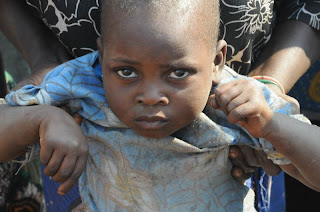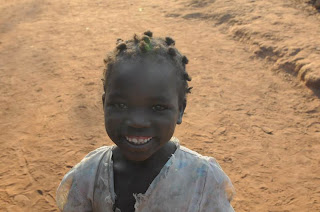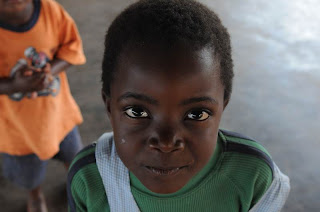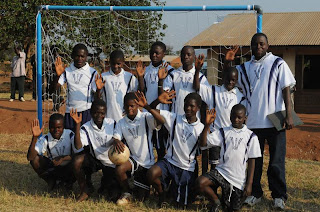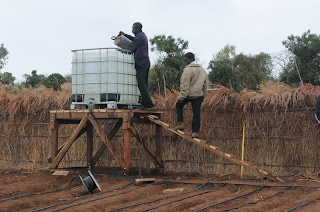 |
| MOH's Daniel is the guy who makes it all happen |
Thursday, September 2, 2010
Sunday, August 22, 2010
Swingset Construction
This year we constructed two more swingsets for the Matapila and Khwamba feeding centers. (The first two are at Katondo and Chimwang'ombe). Again we selected Bluegum wood for it's hardness and weight. Purchasing wood at the open air wood market in oldtown Lilongwe is always an adventure! MOH's carpenter and lorry driver Lamech again provided invaluable assistance, and of course Daniel as well.
There is nothing like the experience of watching the kids, who have never seen a swing before, when the frame is completed and the swing chains and seats are finally hung. They literally have to be shown how to use the swings. But once they quickly learn, the screams and laughter from the feeling of weightlessness makes the work so worthwhile!
There is nothing like the experience of watching the kids, who have never seen a swing before, when the frame is completed and the swing chains and seats are finally hung. They literally have to be shown how to use the swings. But once they quickly learn, the screams and laughter from the feeling of weightlessness makes the work so worthwhile!
 |
| The first step is purchasing the wood in the old Lilongwe lumber market. Not exactly Home Depot . . . |
 |
| Building without electricity. Drilling into "rock hard" bluegum is always the biggest challenge. The solution is lots of madsi (Chichewa=water). Daniel is drilling; Lamech in the red hat. |
 | |||
| Construction at Khwamba. Frame is assembled on ground and then lifted onto it's feet. |
 |
| Matapila swings in early morning before kids arrive |
 |
| News travels fast |
 |
| It's a great feeling when a new swing is completed. |
 |
| Lisa commissioned these plaques: each swingset was dedicated in prayer before "commissioning" |
 |
| The Khwamba swings were built under a "spreading" fig tree . . . a picturesque spot. |
 |
| "Swing-training" These swings will get a great deal of use. |
 |
| The ultimate reward for us all. |
 |
| Image from last year's project at Chimwang'ombe: the need is so great Paul |
Saturday, August 21, 2010
Khwamba's "New" Soccer Team
David secured a complete set of used soccer uniforms and we were able to outfit the kids at Khwamba. Here they are in front of the newly constructed soccer goals. We also brought donated soccer balls and an airpump. Soccer is a national passion in Malawi, but often the kids have to make balls from plastic bags compressed and taped into a ball.
 |
| They immediately began "playing like pro's" as we left for home. Maize mill in the background. Paul |
Thursday, August 19, 2010
Tuesday, August 17, 2010
VBS at Matapila and Khwamba
Our VBS programs at the Matapila and Khwamba feeding centers were a great success, and I'm sure many more remembrances by those who participated will be forthcoming. Here are a few images I captured . . . .
Paul
Paul
Farewell to Malawi
Gravity Drip Irrigation at Matapila
This is a brief chronology of our construction of the irrigation system at Matapila. We were able to purchase a 1000 liter tank locally, which will allow us to expand the system 4-fold in the future. Currently the "pilot system" is 10 meters square, with 20 - 10 meter long rows, for which we employed the Chapin drip tape design. Full of water the tank weighs 2000 lbs (one ton), and sits 3.5 meters off of the ground to provide the hydraulic pressure necessary to evenly distribute water to each of the drip tubes! We built the tank stand from Blue Gum wood, an incredibly hard local wood that we also use for the swing sets we've built in Malawi. Our Keith Goeliner had provided valuable suggestions in designing a sturdy stand to support the weight. The plot was sloped, and we mounted the tank at the highest point. We achieved good water distribution, and were able to increase the number of connected drip tapes from the standard design of 10, to 20, allowing better garden planting coverage. Our goal is to facilitate two growing seasons instead of one, and the introduction of vegetables to supplement the traditional maize crop. Malawian soils are dangerously depleted in nutrients and organic matter due to continuous cropping, the burning of plant residues, lack of organic recycling to the soil, ineffective tillage, and lack of water during the dry seasons. Transportation costs make chemical fertilizers much too expensive for practical utilization.
 |
| Constructing the water tank stand |
Moving the completed stand into the garden area. They say many hands make "light work". Still not so "light".
 |
| The "Irrigation Team" |
Joseph, the Matapila Director, later informed us that later that evening after we had completed the irrigation system, his people had planted tomatoes, Chinese cabbage, and rape seedlings previously begun, at each of the drip points. They wasted no time! Can't wait to see photos of the newly planted garden! Such vegetables should contribute major improvement in the diet of the children at Matapila.
Charles, the MOH director, later shared that he regretted not calling in a TV camera crew from Lilongwe to document the installation. He feels that introduction of such a system for the care of orphans will bring valuable attention to the MOH programs.
We plan to expand the irrigation network next year 4 fold, and also develop the Matapila garden to employ organic agricultural techniques. A 100 slide educational presentation we developed was made to Daniel of MOH and Joseph, the Matapila Director to initiate the implementation of composting and other concepts specific to sub-tropical Malawian farming, as well as providing them with our gift of a wet chemistry soil nutrient test kit and pH meter. We hope to make Matapila an LCPC-MOH agricultural development center to implement and demonstrate concepts that can be implemented not only at the other feeding centers, but hopefully that can be observed and carried back to the surrounding villages to make even greater impact upon these remote areas.
Paul Sigmund
Subscribe to:
Comments (Atom)


